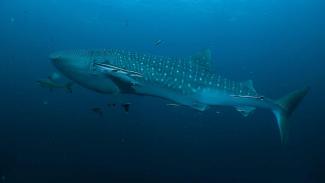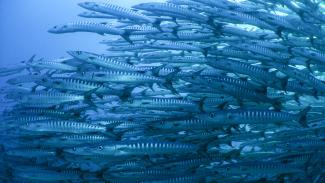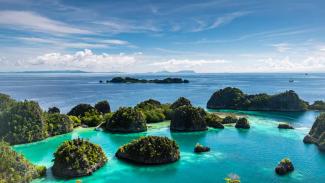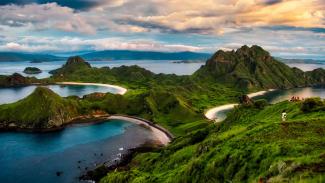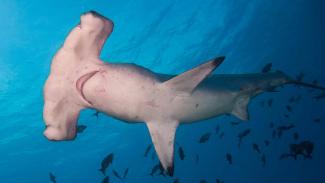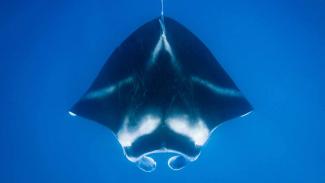Dive into these remote reefs in the Sulu Sea
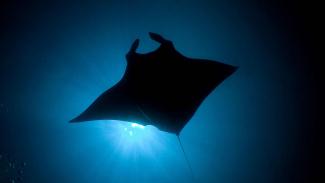
Tara North
Tubbataha Reef in the Philippines may be the country's most famous diving spot, certainly for larger marine life. This small group of islands and atolls that give their name to the Tubbataha Reef National Park lie at the centre of the Sulu Sea.
The depth of the sea brings cold, nutrient rich waters to the surface around these remote atolls. This brings not only large marine life, but a huge biodiversity too.
The Philippine liveaboards only visit during a short season between March and May, Tubbataha Reef is one for the bucket list.
Highlights
Best diving spots
Tubbataha Reefs National Park has two atolls, which plunge down to 650 fathoms. The shallows of the southern atoll have beautiful coral gardens and a kaleidoscope of colourful reef-life, before dropping off at about 24 metres into the abyss.
On the east side, there is a wreck that ran aground and is now perched on the edge of the precipitous drop-off. The west wall is known for its Shark encounters. The atoll runs for 12km north to south. Barracuda, Whitetip & Blacktip Reef Sharks, large numbers of Green and Hawksbill Turtles, Tuna, Trevally and occasionally Manta Rays visit Tubbataha.
The larger northern atoll is famous above water for its bird-life. Thousands of Terns & Boobies jostle for space on a tiny islet at the atoll's northern-most point. Underwater, Tubbataha's northern atoll is equally rich in life.
Amos Rock, at the southern tip, is a superb site. Shallow sandy areas are good for finding smaller species, while the wall has huge Gorgonians & Whip Corals. If the current is running, numerous sharks, including Grey Reef Sharks can sometimes be seen here, along with large Groupers. Turtles are commonly encountered close-by at South Rock.
The western wall has excellent reefs and a small wreck, while the north wall has several crevices and overhangs hiding Nurse Sharks. Other smaller Sharks rest on the sandy reef-top, along with Blue Spotted Stingrays & occasionally larger Rays. Some lucky divers have seen Guitar Sharks here.
Around 20km north-west is Jessie Beazley Reef. The small, oddly named reef is almost perfectly circular. Here you will find numerous Turtles, plus plenty of Reef and Nurse Sharks. The huge sponges here are an impressive sight, while occasionally Hammerhead, Mako & Thresher Sharks cruise the blue.
Basterra Reef lies to the south of Tubbataha. This small reef plunges to the deepest depths of all the sites around here - over 1000 fathoms. At Barracuda Slope, a sandy slope turns into a wall at 16m, where corals are teeming with a kaleidoscope of smaller reef-fish. In the blue, an enormous school of Barracuda can normally be seen hovering in the current.
At the northern end of the reef, Expressway is a current-washed, adrenaline filled dive where you can encounter Manta Rays, Grey Reef Sharks & curious Whitetips. The Oceanic II is a wreck that ran aground on the reef, providing shelter to a huge variety of marine life.
These sites are not for everyone. Seas can be rough and currents can be strong, but the diving here is truly world-class and will not fail to impress even the most jaded diver.
When to dive
Due to its remote location, the reefs and atolls of the Sulu Sea can only be dived in a short season from March through to June each year.
Getting there
The embarkation point for liveaboards to Tubbataha is the town ot Puerto Princessa on Palawan's east coast. From here, it is a journey of about 12 hours by liveaboard across the Sulu Sea
To reach Puerto Princessa, simply take a flight from the international airports in Manila or Cebu.
Activities
Tubbataha is solely a liveaboard destination, so diving is the focus.
Puerto Princessa is known as the eco-tourism capital of the Philippines and most activities are centred around enjoying the area's beautiful landscapes & nature, including plenty of wildlife-based trips. Tours to the local islands and beaches are also very popular.
Shopping and golf are possible and there are plenty of nice restaurants to enjoy.
Resort and liveaboard options
Liveaboards focus on the Tubbataha reefs from March through to June each year, offering six or seven night itineraries out of Puerto Princessa. Due to the short season, there is high demand for trips, so it may be wise to book early.
We recommend the team at Liveaboard.com to find your Tubbataha liveaboard adventure
Did you know?
According to the UNESCO World Heritage Centre the Tubbataha Reefs Natural Park provides an important habitat for internationally threatened and endangered marine species.
The park supports 360 species of corals, almost 90% of all coral species in the Philippines, eleven species of Cetaceans, eleven species of Sharks, and an estimated 700 species of fishes, including the iconic and threatened Napoleon Wrasse.
How to dive Tubbataha
Located in the center of the Sulu Sea and only accessible by liveaboard during a short season fro April through to June, the Tubbataha Marine Park is without doubt one of Asia's finest destinations for thrilling big fish encounters. The plunging reefs attract numerous species of shark, including Grey Reef Sharks, Hammerheads and, in May and June, Whale Sharks. Manta Rays are also seen here, along with large numbers of turtles and plentiful pelagics.
How to dive Tubbataha
Tubbataha can only be dived by liveaboard due to its remote location, with liveaboards departing from Puerto Princessa in Palawan. The crossing to Tubbataha is long and can be rough, so a sturdy steel-bottomed liveaboard is best suited to these waters.
Options include the highly regarded Sea Doors vessel, the outstanding Solitude One or the new Philippines Aggressor. Those on a tighter budget may wish to consider the Azalea or the Resolute. All are available to book via the team at Liveaboard.com. Booking early is recommended due to high demand and a short diving season.
Tubbataha Snapshot
- When to go: Accessible by liveaboard from April through to June.
- Marine life highlights: Numerous shark species, Manta Rays, Pelagics.
- How to reach: Join a liveaboard from Puerto Princessa.
- Prices guide: Liveaboards begin from around USD160 per night, but most options are upwards of USD250 per night.


